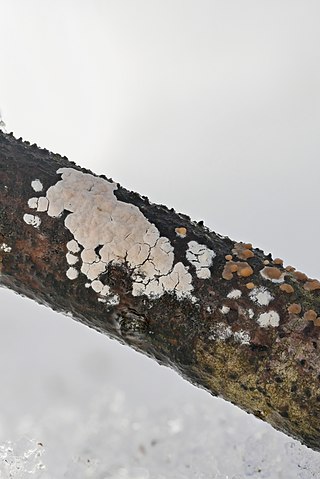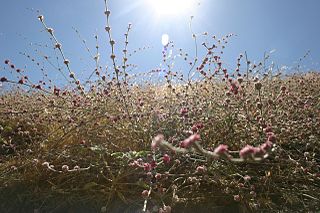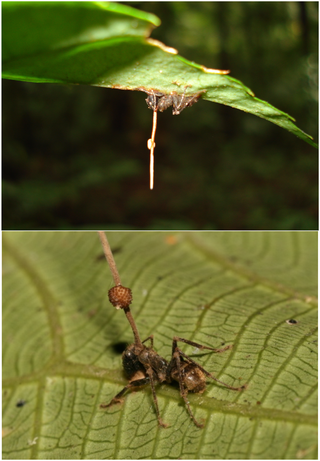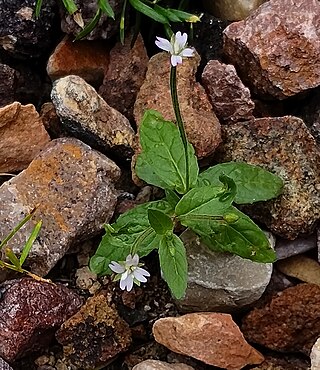The Thermomicrobia is a group of thermophilic green non-sulfur bacteria. Based on species Thermomicrobium roseum and Sphaerobacter thermophilus, this bacteria class has the following description:
Sphaerobacter is a genus of bacteria. When originally described it was placed in its own subclass (Spahaerobacteridae) within the class Actinomycetota. Subsequently, phylogenetic studies have now placed it in its own order Sphaerobacterales within the phylum Thermomicrobiota. Up to now there is only one species of this genus known. The closest related cultivated organism to S. Thermophilus is the Thermomicrobium Roseum and has an 87% sequence similarity which indicates that S. Thermophilus is one of the most isolated bacterial species.[4]
Clonostachys rosea f. rosea, also known as Gliocladium roseum, is a species of fungus in the family Bionectriaceae. It colonizes living plants as an endophyte, digests material in soil as a saprophyte and is also known as a parasite of other fungi and of nematodes. It produces a wide range of volatile organic compounds which are toxic to organisms including other fungi, bacteria, and insects, and is of interest as a biological pest control agent.

Corticium roseum is a species of fungus in the family Corticiaceae. Basidiocarps are effused, smooth, corticioid, and pink. The species has a wide, north and south temperate distribution and in Europe is typically found on dead, attached branches of Salix and Populus.

Eriogonum roseum is a species of wild buckwheat known by the common name wand buckwheat. It is native to much of western California and the Sierra Nevada foothills, as well as parts of Oregon, and it is widespread and common in several plant communities.

Dipodium roseum, commonly known as rosy hyacinth-orchid or pink hyacinth-orchid, is a leafless saprophytic orchid found in east and south-eastern Australia. In summer it produces a tall flowering stem with up to fifty pale pink flowers with small, dark red spots. A widespread and common species it is often confused with D. punctatum but has darker, less heavily spotted flowers.

Ophiocordycipitaceae is a family of parasitic fungi in the Ascomycota, class Sordariomycetes. It was updated in 2020.

Allium roseum, commonly called rosy garlic, is an edible, Old World species of wild garlic. It is native to the Mediterranean region and nearby areas, with a natural range extending from Portugal and Morocco to Turkey and the Palestine region. It is cultivated widely, and has become naturalised in scattered locations in other regions outside its natural range.

Purpureocillium is a fungal genus in the Ophiocordycipitaceae family. The genus now contains at least 5 species with the type species Purpureocillium lilacinum, a common saprobic, filamentous fungus. It has been isolated from a wide range of habitats, including cultivated and uncultivated soils, forests, grassland, deserts, estuarine sediments and sewage sludge, and insects. It has also been found in nematode eggs, and occasionally from females of root-knot and cyst nematodes. In addition, it has frequently been detected in the rhizosphere of many crops. The species can grow at a wide range of temperatures – from 8 to 38 °C for a few isolates, with optimal growth in the range 26 to 30 °C. It also has a wide pH tolerance and can grow on a variety of substrates. P. lilacinum has shown promising results for use as a biocontrol agent to control the growth of destructive root-knot nematodes.

Purpureocillium lilacinum is a species of filamentous fungus in the family Ophiocordycipitaceae. It has been isolated from a wide range of habitats, including cultivated and uncultivated soils, forests, grassland, deserts, estuarine sediments and sewage sludge, and insects. It has also been found in nematode eggs, and occasionally from females of root-knot and cyst nematodes. In addition, it has frequently been detected in the rhizosphere of many crops. The species can grow at a wide range of temperatures – from 8 to 38 °C for a few isolates, with optimal growth in the range 26 to 30 °C. It also has a wide pH tolerance and can grow on a variety of substrates. P. lilacinum has shown promising results for use as a biocontrol agent to control the growth of destructive root-knot nematodes.

Hormathophylla spinosa, formerly Alyssum spinosum, the spiny madwort, is a species of flowering subshrub in the genus Hormathophylla of the family Brassicaceae, native to open rocky sites in south-eastern France and southern Spain. It forms a compact mound up to 30 cm in height. Dense spiny branches of tiny, toothed grey-green leaves bear racemes of white flowers at the tips in early summer.

Trichothecium roseum is a fungus in the division Ascomycota first reported in 1809. It is characterized by its flat and granular colonies which are initially white and develop to be light pink in color. This fungus reproduces asexually through the formation of conidia with no known sexual state. Trichothecium roseum is distinctive from other species of the genus Trichothecium in its characteristic zigzag patterned chained conidia. It is found in various countries worldwide and can grow in a variety of habitats ranging from leaf litter to fruit crops. Trichothecium roseum produces a wide variety of secondary metabolites including mycotoxins, such as roseotoxins and trichothecenes, which can infect and spoil a variety of fruit crops. It can act as both a secondary and opportunistic pathogen by causing pink rot on various fruits and vegetables and thus has an economical impact on the farming industry. Secondary metabolites of T. roseum, specifically Trichothecinol A, are being investigated as potential anti-metastatic drugs. Several agents including harpin, silicon oxide, and sodium silicate are potential inhibitors of T. roseum growth on fruit crops. Trichothecium roseum is mainly a plant pathogen and has yet to show a significant impact on human health.

Rhodobryum roseum, commonly known as rose moss, is a species of moss of the subclass Bryidae and family Bryaceae, found throughout most of the world in woods or sheltered grassy places. It rarely forms sporophytes and spore cases, and primarily reproduces vegetatively by stolons, horizontal stems that root at the nodes, resulting in populations of plants that are sterile or only female.

Purpureocillium atypicola is a species of fungus, previously known as Nomuraea atypicola, in the family Ophiocordycipitaceae with no subspecies listed in the Catalogue of Life. There are records of this mushroom from Japan, Australia and New Zealand.

Epipogium roseum, commonly known as ghost orchid, leafless nodding orchid or 虎舌兰 , is a leafless terrestrial mycotrophic orchid in the family Orchidaceae. It has up to sixteen cream-coloured, yellowish or pinkish flowers with an enlarged ovary on a fleshy hollow flowering stem. This ghost orchid is widely distributed in tropical Africa, Asia, Southeast Asia, New Guinea, Australia and some Pacific Islands.

Epilobium roseum is a species of flowering plant belonging to the family Onagraceae.
Purpureocillium lavendulum is a species of fungus in the genus Purpureocillium in the order of Hypocreales.
Purpureocillium sodanum is a species of fungus in the genus Purpureocillium in the order of Hypocreales.











